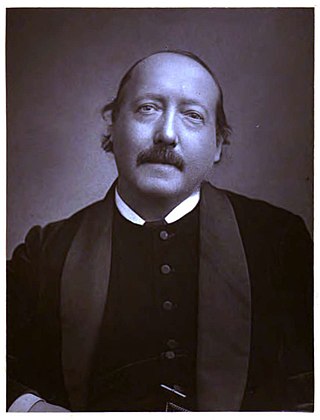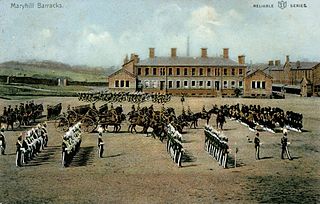
Maryhill is an area in the north-west of Glasgow in Scotland. A former independent burgh and the heart of an eponymous local authority ward, its territory is bisected by Maryhill Road, part of the A81 road which runs for a distance of roughly three miles between Glasgow city centre and the suburban town of Bearsden.

Andrew Watson was a Scottish footballer who is widely considered to be the first black person to play association football at international level. He played three matches for Scotland between 1881 and 1882. Arthur Wharton was previously commonly thought to be the first black player, as he was the first black professional footballer to play in the Football League, but Watson's career predated him by over a decade. There is evidence that Watson was paid professionally when at Bootle in 1887, two years prior to Wharton becoming a professional with Rotherham Town; however, the Merseyside club did not play in the Football League at the time Watson played there.

North Kelvinside is a residential district of the Scottish city of Glasgow.

Patricia Josephine Ferguson is a Scottish politician who has served as Member of Parliament (MP) for Glasgow West since the 2024 United Kingdom general election. Ferguson is also a Glasgow City Council Councillor.

Industrial schools were intended to solve problems of juvenile vagrancy in England by removing poor and neglected children from their home environment to a boarding school. The Industrial Schools Act 1857 allowed magistrates to send disorderly children to a residential industrial school. An 1876 act led to nonresidential day schools of a similar kind.

Anniesland railway station is a railway station that serves the Anniesland suburb of Glasgow, Scotland.
The Glasgow, Yoker and Clydebank Railway was a railway company that opened in 1882, giving a rail connection to shipyards and other industry that developed in what became Clydebank. At first it was a purely local line, connecting only at Stobcross with the North British Railway, but as industry developed in the area it served it became increasingly important.
The Stobcross Railway was a railway line in Glasgow, Scotland, built by the North British Railway to connect from Maryhill to the new dock being built at Stobcross; the dock became the Queen's Dock, opened in 1877. The line was opened first, in 1874, and gave the North British company access to the north bank of the River Clyde; there was a goods depot at Partick.

Wyndford is an area of the city of Glasgow, Scotland. Located two miles northwest of the city centre in Maryhill, Wyndford is bounded by Maryhill Road to the north and the River Kelvin to the south. The area comprises council housing that is typical of that which was built throughout Glasgow in the 1960s and 1970s. The houses are now either privately owned or mainly run by Wheatley Homes Glasgow. The community is represented by the Wyndford Residents Union, who oppose the proposed demolition of four high-rise tower blocks in the area and are, as of March 2024, involved in a legal dispute with Glasgow City Council over the demolition.
The Glasgow Central Railway was a railway line built in Glasgow, Scotland by the Caledonian Railway, running in tunnel east to west through the city centre. It was opened in stages from 1894 and opened up new journey opportunities for passengers and enabled the Caledonian Railway to access docks and industrial locations on the north bank of the River Clyde. An intensive and popular train service was operated, but the long tunnel sections with frequent steam trains were smoky and heartily disliked.
The Lanarkshire and Dumbartonshire Railway was a railway company in Scotland. It was promoted independently but supported by the Caledonian Railway, and it was designed to connect Balloch and Dumbarton with central Glasgow, linking in heavy industry on the north bank of the River Clyde. From Dumbarton to Balloch the line would have closely duplicated an existing railway, and negotiation led to the latter being made jointly operated, and the L&DR terminated immediately east of Dumbarton, trains continuing on the joint section.

Robert Joseph "Bob" Doris is a Scottish National Party (SNP) politician. He has served as the Member of the Scottish Parliament (MSP) for Glasgow Maryhill and Springburn since the 2016 Scottish Parliament election, having previously served as an MSP for Glasgow from 2007 to 2016.
The Glasgow to Aberfoyle Line was a railway line in Scotland, built in stages, leaving the Edinburgh and Glasgow Railway near Lenzie. Tourist traffic was a dominant part of the motivation for building the line, and road tours to the Trossachs from Aberfoyle formed a significant part of the traffic.
The Glasgow, Dumbarton and Helensburgh Railway was independently sponsored to build along the north of the River Clyde. It opened in 1858, joining with an earlier local line serving Balloch. Both were taken over by the powerful North British Railway in 1865, and for some time the line was the main route in the area. As industry developed other lines were opened to serve it, and the line formed the core of a network in the area.

William Davenport Adams was an English journalist, drama critic, and author. He was the son of the prolific author William Henry Davenport Adams, and his wife and two sisters also wrote.

Maryhill Barracks was built on 12 hectares of the Ruchill estate, in the Maryhill area of northern Glasgow, Scotland.
The Kelvin Valley Railway was an independent railway designed to connect Kilsyth, an important mining town in central Scotland, with the railway network. It connected Kilsyth to Kirkintilloch and thence over other railways to the ironworks of Coatbridge, and to Maryhill, connecting onwards to the Queen's Dock at Stobcross.
The Kilsyth and Bonnybridge Railway was a railway line in central Scotland, built to exploit the mineral extractive industries in the area; it opened in 1888. A passenger service was run, but bus competition overwhelmed it after 1920 and the passenger service closed in 1935. The goods and mineral traffic continued, but it was dependent on the industries it served, and when they declined so did the business on the railway; it closed in 1964 and none of it is now in railway use.
Lochburn Park is a football stadium in the Maryhill area of Glasgow, Scotland. It is the home ground Maryhill F.C. of the Scottish Junior Football Association West Region, who have played there since the late 19th century.

Maryhill Burgh Halls is a local heritage site located in the Maryhill area of Glasgow, a few miles North-West of Glasgow city centre. Maryhill Burgh Halls was initially opened in 1878 as a municipal building complex, which served as a police station and fire station until the 1970s. The complex fell into disuse and disrepair especially towards the late 20th century, and plans for its demolishment were proposed. However, as a result of local campaigning, the decision was taken to restore the complex and for it to be used as a community resource. Repairs, selective demolition, restoration, and development work took place between 2008 and 2011. The halls re-opened in April 2012.











